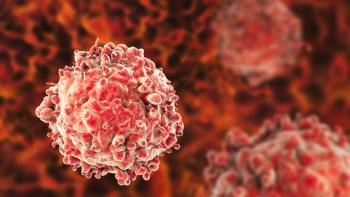
Patients With Breast Cancer May Have Increased Risk for Medication-Related Osteonecrosis of the Jaw
Compared with available literature, the rates of medication-related osteonecrosis of the jaw were higher in patients with breast cancer and bone metastases treated with antiresorptive therapy.
Incidence of medication-related osteonecrosis of the jaw (MRONJ) may be higher in patients with breast cancer with bone metastases, especially in those treated with denosumab, according to findings published in the Journal of Clinical Oncology.
“Patients must be made aware of this potential adverse event of the drug and be educated accordingly,” the study authors wrote. “The item dental examination should be on the pretreatment checklist of every clinician potentially prescribing or administering antiresorptive therapy. Dental follow-up visits should be scheduled on a regular basis to provide adjusted dental care and—in case of an emerging MRONJ—to spot first signs and symptoms of MRONJ and take appropriate actions accordingly.”
Of the 639 patients in the study, MRONJ occurred in 56 patients (8.8%; 95% CI, 6.6%-11.0%).
“This is an important finding since MRONJ can severely affect the quality of life in this highly vulnerable patient collective,” the study authors wrote.
The cumulative difference was measured in patients treated with denosumab only (11.6%; 95% CI, 8.0%-15.3%), bisphosphonates only (2.8%; 95% CI, 0.7%-4.8%), and bisphosphonates followed by denosumab (16.3%; 95% CI, 8.8%-23.9%).
“Patients in our cohort on bisphosphonates only were significantly less likely to develop MRONJ compared with individuals on denosumab only,” the study authors wrote.
Notably, the development of MRONJ was significantly different over time depending on the antiresorptive therapy a patient received (Gray’s test, P < .0001). The median time to the development of MRONJ after treatment initiation was 4.6 years for individuals treated with denosumab only, 8.4 years for those treated with bisphosphonates followed by denosumab, and 5.1 years for patients treated with bisphosphonates only.
After a diagnosis of MRONJ, patients had a median overall survival of 7.9 years for those treated with denosumab only, 5.6 years for those treated with bisphosphonates only, and 10.7 years for those treated with bisphosphonates followed by denosumab.
The main analysis of this study demonstrated a statistically significant higher risk for developing MRONJ in patients treated with denosumab only and those receiving both denosumab and bisphosphonate compared with patients treated with bisphosphonate only. After adjusting for confounders including age at diagnosis, primary or secondary metastases, menopausal status, use of corticosteroids, osteoporosis, and HER2-positive, hormone receptor-positive, and triple-negative breast cancer, the ORS were 18.8 (95% CI, 2.4-145.2) for treatment with denosumab only and 17.8 (95% CI, 2.2-147.5) for bisphosphonate and denosumab.
Of the 8860 patients screened for eligibility, 639 were included in this study. The exclusion criteria for the study were no bone metastases, no antiresorptive therapy, unknown MRONJ status, and missing data.
Patients included in this study were diagnosed with breast cancer and bone metastases (primary and secondary) between 2000 and 2020. In addition, patients received treatments of denosumab only (n = 292), bisphosphonates only (n = 255), or bisphosphonates and denosumab sequentially (n = 92).
The primary outcome of this study was the population-based incidence of MRONJ. Secondary outcomes included correlation between antiresorptive therapy and the risk for MRONJ, and time from cancer to a diagnosis of MRONJ. Once MRONJ was suspected by a physician, patients were referred to the outpatient clinic of the Craniomaxillofacial and Oral Surgery Department, where they were examined by an experienced specialist.
“Although tumor survival rates and avoidance of primary disease complications remain the main concern in oncology, the considerably higher risk of MRONJ should also be taken into consideration when treating patients with antiresorptive therapy,” the study authors concluded.
Reference
Brunner C, Arvandi M, Marth C, et al. Incidence of Medication-Related Osteonecrosis of the Jaw in Patients With Breast Cancer During a 20-Year Follow-Up: A Population-Based Multicenter Retrospective Study. J Clin Oncol. Published online August 20, 2024. doi:10.1200/JCO.24.00171
Newsletter
Knowledge is power. Don’t miss the most recent breakthroughs in cancer care.
















































































